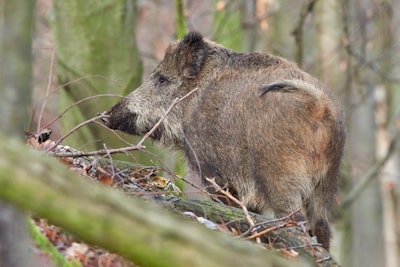
In the second week of this month, the authorities in Italy confirmed the first case of African swine fever (ASF) in the region of Emilia-Romagna.
Testing positive for the virus was a wild boar in the province of Piacenza, according to the official notification to the World Organisation for Animal Health (WOAH).
Emilia-Romagna borders the regions of Liguria, Piedmont and Lombardy, where cases of ASF in wild and domestic animals have been recorded since January 2022. So far, 993 infected wild boar have been identified this area of northwestern Italy.
As well as these four regions, ASF has been detected further south in Lazio, Campania and Calabria in 2022 and 2023, and the disease is considered to be endemic on the island of Sardinia.
The latest case in a new region underscores the critical ASF situation in Italy, according to a pig farmer and member of the council of the Italian farmers' confederation, Confagricoltura.
She said more producers are now subject to restrictions on the movement of their animals, and they are required to intensify biosecurity measures.
Furthermore, she called for the implementation of a proposed plan, which would see the culling of around half of the population of 1.5 million wild boar by 2025.
So far, there have been few outbreaks directly impacting Italy’s pig industry. There have been a total of 16 outbreaks in commercial and backyard herds — nine in Lombardy, six in Calabria and one in Lazio.
5 European nations report new outbreaks in domestic pigs
So far this year, one or more outbreaks of ASF have been recorded in 16 of the nations in this region. This is according to the Animal Disease Information System from the European Commission (EC; as of November 17). This covers notifiable diseases in member states of the European Union (EU) and most of its immediate neighbors.
For the region, the outbreak total stands at 4,339. This compares with 537 recorded outbreaks in 12 European states during the whole of 2022, according to this source. Around 60% of herds affected last year were in Romania.
Registering the most outbreaks in domestic pigs with the EC so far in 2023 is Bosnia-Herzegovina, where the total remains unchanged over the past four weeks at 1,405. Next come Croatia (now with a total for the year to date of 1,113), Serbia (961) and Romania (718). The next highest national total is for Ukraine (31 outbreaks for the year to date).
Since the EC’s previous update dated November 3, four countries confirmed new outbreaks — Serbia (199), Croatia (19), Romania (16) and Ukraine (nine).
Over the past week, veterinary authorities of four European countries have confirmed further ASF outbreaks in their respective domestic swine populations with WOAH.
For Bosnia-Herzegovina, the 80 new outbreaks cover the period from late August to early November, and directly impacted a total of 4,156 pigs.
All the affected premises are described as “backyards,” with most herds of no more than 80 animals. However, nine premises each comprised more than 100 pigs, and two had more than 600.
Most of the latest outbreaks were in Brcko, while the rest were in the Republic of Srpska — both regions where previous cases have been recorded. Within this latter region, first outbreaks were confirmed in the city of East Sarajevo.
Also registering new outbreaks with WOAH has been Romania. Nine further outbreaks across seven counties involved a total of 2,613 pigs. Most of these new outbreaks were in small herds. However, the total includes a further 2,276 pigs affected at a previous farm outbreak.
For Croatia, the number of outbreaks involving domestic pigs has risen by eight. All the latest cases were in herds of 3-26 pigs in the northeastern county of Vukovar-Srijem, where many of the previous outbreaks have occurred, according to the official notification.
There have been two more outbreaks on Ukrainian farms — one in each of the central provinces of Kirovohrad and Poltava.
Outbreak total in wild boar approaches 7,000
So far this year, 20 countries have officially registered with the EC one or more outbreaks of the disease in their wild boar populations (as of November 17).
The regional total for ASF outbreaks involving wild boar recorded through this system stands at 6,952. This is an increase of 174 since the previous update on November 3.
For comparison, 15 European countries covered by the EC System registered a total of 7,442 outbreaks of ASF in this population in the whole of 2022.
To date this year, Poland has reported the most outbreaks in this category (2,465), followed by Germany (863 outbreaks), Italy (859), Latvia (641), Slovakia (521), Hungary (377) and Lithuania (359).
All of these countries had registered new cases since November 3 — along with the Czech Republic, Estonia, Romania, Serbia and Sweden.
In Sweden, the total number of wild boar testing positive for the ASF virus stands at 60, according to the national veterinary authority, SVA (as of November 16).
The country’s first ever cases of the disease were reported at the end of August. All the virus-positive animals have been found in the originally designated disease control zone around the central-south town of Fagersta. No cases have been detected so far in either the nation’s domestic pigs, or in wild boar outside the control zone.
As of November 17, the total number of ASF-infected wild boar in Germany was 5,575, according to national veterinary agency, the Friedrich-Loeffler Institute. Of these, 17 cases were detected over the previous 28 days. The country’s first cases were reported in September 2020.
View our continuing coverage of the global African swine fever situation.
















